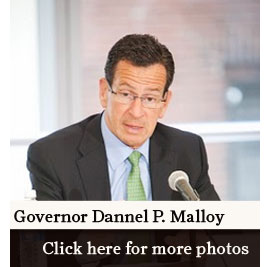Newsroom Archive
Helen Keller once said that “Until the great mass of the people shall be filled with the sense of responsibility for each other's welfare, social justice can never be attained.” On Tuesday, May 13 and Wednesday, May 14 John Jay College and the Center for Media, Crime and Justice enabled Keller’s vision by holding a two-day conference for senior editors from around the country called, “Under the Gun: Gun Violence, Gun Laws and the Media.” “Under the Gun” is part of John Jay’s semester-long series of events to honor the lives that were lost during the tragedy that occurred at Newtown CT, called “Remembering Newtown.” In conjunction with John Jay’s response to the tragedy, this conference is part of a two-year series designed to apprise journalists of the latest research and scholarship on gun violence and firearms safety.
 The conference consisted of a series of roundtable discussions led by panels of experts discussing nuanced topics such as, “The Politics of Guns: Reigniting an Old Debate” led by Governor Dannel Malloy from Connecticut, Professor Robert Spitzer from SUNY Cortland, and Robyn Thomas, Executive Director of the Law Center to Prevent Gun Violence in San Francisco.
The conference consisted of a series of roundtable discussions led by panels of experts discussing nuanced topics such as, “The Politics of Guns: Reigniting an Old Debate” led by Governor Dannel Malloy from Connecticut, Professor Robert Spitzer from SUNY Cortland, and Robyn Thomas, Executive Director of the Law Center to Prevent Gun Violence in San Francisco.
Other featured speakers included Mayor Michael Nutter of Philadelphia, current president of the U.S. Conference of Mayors, and Mayor R.T. Rybak of Minneapolis.
The roundtables covered multiple dimensions of the nation’s debate on addressing gun violence, including : “American Trauma: Gun Violence, Public Health and Mental Illness”; “Guns, Gangs and Kids: Tackling Gun Safety in a Culture of Violence”; “What Works & What Doesn’t: Courts and Cops”; and “America and The World.
The final roundtable looked at “Gun Economics: Technology, Public Safety and the Market.” Discussants included Mayors Nutter and Rybak; Joe Bartozzi, VP/General Counsel of O.F. Mossberg & Sons, CT; and Dr. Shannon Frattaroli, John Hopkins School of Public Health.
President Travis provided welcoming remarks at an introductory lunch on Tuesday.
“The work journalists do helps to contribute to the public understanding of these complicated policy questions and research questions, and cultural questions,” said President Travis. “Through these conferences journalists and experts (are brought together) for closed room discussions, so journalists have a better understanding of complicated issues. A number of journalists said they had lost focus on gun violence, and Newtown has brought these issues back into focus. We want to sustain that focus.”
“We are honored by the presence of Governor Malloy from Connecticut. We all watched you and your state and Newtown go through one of the more horrific experiences that any one of us could imagine. We valued your steady hand in the way you navigated through a lot of grief and trauma and a lot of complicated politics,” said Travis.
Stephen Handelman, Director of the Center for Media, Crime and Justice, welcomed the group of elite journalists and explained that the purpose of the Center and the conferences were to serve as a bridge between academia and research and journalists, and to fill the void between the latest scholarly activity and stories written by journalists.
“We are not here to advocate a particular idea or view,” he said. “Our concept was to bring a very small group, leading editors, columnists from around the country to think about gun control, violence, and responsibility beyond the usual contours of the debate. We’ve living under the shadow of Newtown but also the shadow of the failure to enact any meaningful federal legislation.”
Governor Malloy discussed the event that occurred on December 14 in Newtown, CT, describing one of his best decisions to assign a police officer to each family. He established a Sandy Hook Commission to investigate the tragedy and the Statehouse responded by organizing their own bipartisan commission investigating the gun issue. Malloy said that although the negotiations over the bill were onerous and did not include items he wanted, he said, “We got a pretty good package, one of the best if not the best legislation.”
Professor Spitzer discussed the historical context for the gun law debate and Robyn Thomas discussed legislation since Newtown. Although the legislation failed to pass in the Senate, she predicted seven states this year will pass significant gun law packages. She reported a tremendous increase in gun regulation at the state level--250 percent. Overall gun violence has decreased significantly in major cities.
Handelman asked the panelists where the emphasis on gun legislation should be in the public debate leading up to the 2014 midterm elections.
“If we keep treating the NRA as if it is a real organization that is advocating on behalf of people as oppose an entity that advocates on behalf of the industry we will be in the (same) situation we are in,” said Governor Malloy “This moral equivalency that our media has moved to over the last 30 years is the reason we’re having the problem,”.
The final roundtable discussed, among many things, the marketability of gun safety technology, such as a ring worn by the certified owner of a gun that only allows a gun to fire if the owner is operating it.
“I am a strong believer in the Second Amendment, but I also have a First Amendment right not to be shot. And if we can engage in best practices and make sure we are all safe and utilize the best of technology, then we can have a safer United States of America,” said Mayor Nutter.
 Inside JJC (Faculty & Staff)
Inside JJC (Faculty & Staff) Technology Services Status
Technology Services Status

